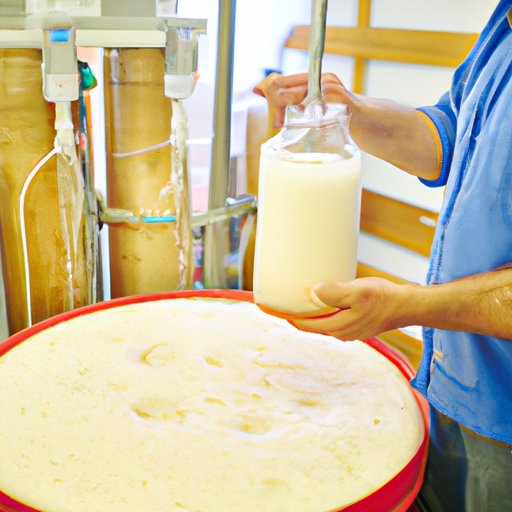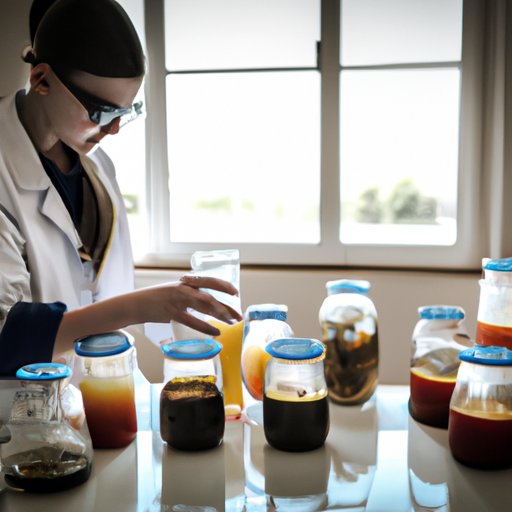Introduction
Fermentation is a process that has been used for centuries to preserve food and create alcoholic beverages. It involves transforming carbohydrates into energy using bacteria, enzymes, and microorganisms, resulting in a variety of flavors and textures. In this article, we will explore how fermentation works, the role of yeast in fermentation, the different types of fermentations, the benefits of fermented foods, and the impact of temperature on the rate of fermentation.

Explaining the Basic Process of Fermentation
The basic process of fermentation begins with a carbohydrate source, such as sugar or starch, which is broken down into simpler compounds. Enzymes then convert these compounds into alcohol and carbon dioxide, creating the byproducts of fermentation. During this process, certain microorganisms, such as yeasts and bacteria, play an important role in breaking down the carbohydrates and creating the desired product.

Examining the Role of Yeast in Fermentation
Yeast is an essential component of fermentation, as it helps to break down the carbohydrates and produce alcohol. There are two main types of yeast used in fermentation: brewers’ yeast and baking yeast. Brewers’ yeast is typically used in the production of beer, while baking yeast is used to make bread and other baked goods. Both types of yeast help to create the desired flavor and texture of the final product.
In addition to providing flavor and texture, yeast also plays a key role in preserving food. As yeast consumes the carbohydrates, it produces alcohol, which is an effective preservative. This makes it possible to store food without refrigeration or other methods of preservation.

Investigating Different Types of Fermentations
There are several different types of fermentations, each with its own unique set of characteristics. Alcoholic fermentation is the most common type of fermentation and is used to create beer, wine, and other alcoholic beverages. Lactic acid fermentation is used to produce yogurt, cheese, and other dairy products, while acetic acid fermentation is used to make vinegar.
Describing the Benefits of Fermented Foods
Fermented foods offer a number of nutritional and health benefits. The fermentation process breaks down the carbohydrates into simpler compounds, making it easier for the body to digest and absorb nutrients. In addition, fermented foods contain probiotics, which are beneficial bacteria that can help improve digestion and boost the immune system.
Fermented foods are also naturally preserved, meaning that they can be stored for longer periods of time without spoiling. This makes them an ideal choice for those looking to stock up on healthy foods without having to worry about them going bad.

Comparing Natural and Industrial Fermentations
Natural fermentation is the traditional method of preserving food through the use of bacteria, enzymes, and microorganisms. Industrial fermentation is a more modern method that uses laboratory-controlled conditions to produce large quantities of food in a shorter amount of time. While industrial fermentation offers the benefit of speed and efficiency, natural fermentation allows for greater control over the taste and quality of the final product.
Analyzing the Impact of Temperature on Fermentation
Temperature plays an important role in the fermentation process, as it affects the rate at which the carbohydrates are broken down. Generally speaking, warmer temperatures will result in faster fermentation, while cooler temperatures will slow down the process. The optimal temperature for fermentation depends on the type of fermentation being used, with most fermentations taking place between 60 and 80 degrees Fahrenheit.
Exploring the History of Fermentation
Fermentation has been used since ancient times to preserve food and create alcoholic beverages. In ancient Egypt, wine was fermented from grapes, while in ancient China, rice was fermented to create a type of beer known as koji. Over the centuries, fermentation has evolved to include a wide range of applications, from the production of cheese and yogurt to the creation of alcoholic beverages such as beer and wine.
Conclusion
Fermentation is a complex process that has been used for centuries to preserve food and create alcoholic beverages. The fermentation process involves the use of enzymes, microorganisms, and yeast to break down carbohydrates and create desirable flavors and textures. Different types of fermentations can be used to produce a variety of foods and beverages, each with its own unique set of benefits. Temperature is also an important factor when it comes to fermentation, as it affects the rate at which the carbohydrates are broken down. Understanding the science behind fermentation can help us better appreciate the foods and beverages that have been created by this age-old process.
With this knowledge, we can now take a closer look at the foods and drinks we consume and appreciate the hard work that went into their production. From ancient civilizations to modern-day applications, fermentation has played an integral role in food preservation and the creation of delicious treats.
(Note: Is this article not meeting your expectations? Do you have knowledge or insights to share? Unlock new opportunities and expand your reach by joining our authors team. Click Registration to join us and share your expertise with our readers.)
